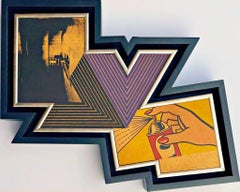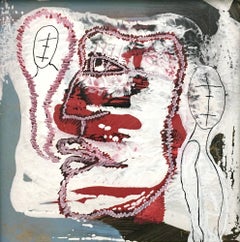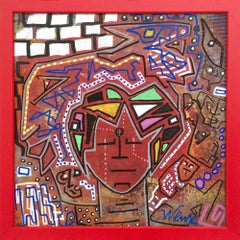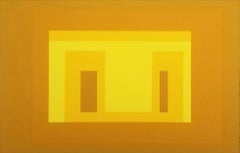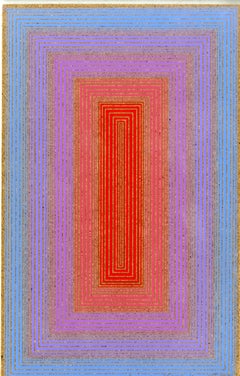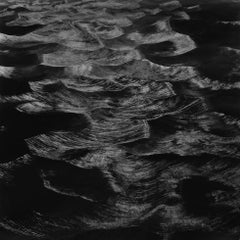Masonite Abstract Prints
to
2
2
Overall Width
to
Overall Height
to
2
1
2
1
1
2
2
1
1
3
1
1,354
7,507
3,941
3,531
2,690
1
2
2
Medium: Masonite
Richard Pettibone The Appropriation Warhol, Stella, Lichtenstein, Unique Signed
Located in New York, NY
Richard Pettibone
The Appropriation Print Andy Warhol, Frank Stella, Roy Lichtenstein, 1970
Silkscreen in colors on masonite board (unique variant on sculpted board)
Hand-signed by artist, Signed and dated on the front (see close up image)
Bespoke frame Included
This example of Pettibone's iconic Appropriation Print is silkscreened on masonite board rather than paper, giving it a different background hue, and enabling it work to be framed so uniquely.
The Appropriation print is one of the most coveted prints Pettibone ever created ; the regular edition is on a full sheet with white background; the present example was silkscreened on board, allowing it to be framed in 3-D. While we do not know how many examples of this graphic work Pettibone created, so far the present work is the only one example we have ever seen on the public market since 1970. (Other editions of The Appropriation Print have been printed on vellum, wove paper and pink and yellow paper.)
This 1970 homage to Andy Warhol, Frank Stella and Roy Lichtenstein exemplifies the type of artistic appropriation he was engaging in early on during the height of the Pop Art movement - long before more contemporary artists like Deborah Kass, Louise Lawler, etc. followed suit.
This silkscreen was in its original 1970 vintage period frame; a bespoke custom hand cut black wood outer frame was subsequently created especially to house the work, giving it a distinctive sculptural aesthetic.
Measurements:
Framed 14.5 inches vertical by 18 inches horizontal by 2 inches
Work
13 inches vertical by 16.5 inches horizontal
Richard Pettibone biography:
Richard Pettibone (American, b.1938) is one of the pioneering artists to use appropriation techniques. Pettibone was born in Los Angeles, and first worked with shadow boxes and assemblages, illustrating his interest in craft, construction, and working in miniature scales. In 1964, he created the first of his appropriated pieces, two tiny painted “replicas” of the iconic Campbell’s soup cans by Andy Warhol (American, 1928–1987). By 1965, he had created several “replicas” of paintings by American artists, such as Warhol, Roy Lichtenstein (1923–1997), Ed Ruscha (b.1937), and others, among them some of the biggest names in Pop Art. Pettibone chose to recreate the work of leading avant-garde artists whose careers were often centered on themes of replication themselves, further lending irony to his work. Pettibone also created both miniature and life-sized sculptural works, including an exact copy of Bicycle Wheel by Marcel Duchamp (French, 1887–1968), and in the 1980s, an entire series of sculptures of varying sizes replicating the most famous works of Constantin Brancusi (Romanian, 1876–1957). In more recent years, Pettibone has created paintings based on the covers of poetry books by Ezra Pound, as well as sculptures drawn from the grid compositions of Piet Mondrian (Dutch, 1872–1944). Pettibone straddles the lines of appropriation, Pop, and Conceptual Art, and has received critical attention for decades for the important questions his work raises about authorship, craftsmanship, and the original in art. His work has been exhibited at the Institute for Contemporary Art in Philadelphia, the Museum of Modern Art in New York, the Museum of Contemporary Art in Miami, and the Laguna Art Museum in Laguna Beach, CA. Pettibone is currently based in New York.
"I wished I had stuck with the idea of just painting the same
painting like the soup can and never painting another painting.
When someone wanted one, you would just do another one.
Does anybody do that now?"
Andy Warhol, 1981
Since the mid-1960s, Richard Pettibone has been making
hand-painted, small-scale copies of works by other artists — a
practice due to which he is best known as a precursor of appropriation art — and for a decade now, he has been revisiting subjects from across his career. In his latest exhibitions at
Castelli Gallery, Pettibone has been showing more of the “same”
paintings that had already been part of his 2005–6 museum retrospective,1
and also including “new” subject matter drawn from
his usual roster of European modernists and American postwar
artists. Art critic Kim Levin laid out some phases of the intricate spectrum from copies to repetitions in her review of the
Warhol-de Chirico showdown, a joint exhibition at the heyday
of appropriation art in the mid-1980s when Warhol’s appropriations of de Chirico’s work effectively revaluated “the grand
old auto-appropriator”.
Upon having counted well over a dozen
Disquieting Muses by de Chirico, Levin speculated: “Maybe he
kept doing them because no one got the point. Maybe he needed the money. Maybe he meant it when he said his technique
had improved, and traditional skills were what mattered.”
On
the other side, Warhol, in her eyes, was the “latter-day exemplar
of museless creativity”.
To Pettibone, traditional skills certainly
still matter, as he practices his contemporary version of museless creativity. He paints the same painting again and again,
no matter whether anybody shows an interest in it or not. His
work, of course, takes place well outside the historical framework of what Levin aptly referred to as the “modern/postmodern wrestling match”,
but neither was this exactly his match
to begin with.
Pettibone is one of appropriation art’s trailblazers, but his diverse
selection of sources removes from his work the critique of the
modernist myth of originality most commonly associated with
appropriation art in a narrow sense, as we see, for example, in
Sherrie Levine’s practice of re-photographing the work of Walker
Evans and Edward Weston. In particular, during his photorealist
phase of the 1970s, Pettibone’s sources ranged widely across
several art-historical periods. His appropriations of the 1980s
and 1990s spanned from Picasso etchings and Brancusi sculptures to Shaker furniture and even included Ezra Pound’s poetry.
Pettibone has professed outright admiration for his source artists, whose work he shrinks and tweaks to comic effect but, nevertheless, always treats with reverence and care. His response
to these artists is primarily on an aesthetic level, owing much
to the fact that his process relies on photographs. By the same
token, the aesthetic that attracts him is a graphic one that lends
itself to reproduction. Painstakingly copying other artists’ work by hand has been a way of making
it his own, yet each source is acknowledged in
his titles and, occasionally, in captions on white
margins that he leaves around the image as an
indication that the actual source is a photographic image. The enjoyment he receives in copying
is part of the motivation behind doing it, as is
the pleasure he receives from actually being with
the finished painting — a considerable private
dimension of his work. His copies are “handmade
readymades” that he meticulously paints in great quantities in his studio upstate in New York; the commitment
to manual labor and the time spent at material production has
become an increasingly important dimension of his recent work.
Pettibone operates at some remove from the contemporary art
scene, not only by staying put geographically, but also by refusing to recoup the simulated lack of originality through the
creation of a public persona.
In so doing, Pettibone takes a real
risk. He places himself in opposition to conceptualism, and he is
apprehensive of an understanding of art as the mere illustration
of an idea. His reading of Marcel Duchamp’s works as beautiful
is revealing about Pettibone’s priorities in this respect.
When
Pettibone, for aesthetic pleasure, paints Duchamp’s Poster for
the Third French Chess...
Category
1970s Pop Art Masonite Abstract Prints
Materials
Masonite, Pencil, Screen
Richard Anusziewicz Annual Edition. Limited Ed. Op Art silkscreen on masonite
Located in New York, NY
Richard Anuszkiewicz
Annual Edition, 1987-1988
Limited edition silkscreen on masonite
Signed and dated by the artist lower right in pencil
Frame Included (floated within a box frame)...
Category
1980s Abstract Geometric Masonite Abstract Prints
Materials
Masonite, Screen
Untitled by Enzio Wenk, 2017 - Acrylic Paint on Masonite, Abstract Expressionism
By Enzio Wenk
Located in Bresso, IT
Acrylic paint on masonite.
The frame was painted by the artist.
Category
2010s Abstract Expressionist Masonite Abstract Prints
Materials
Masonite, Acrylic
Untitled by Enzio Wenk, 2017 - Acrylic Paint on Masonite, Neo-Expressionism
By Enzio Wenk
Located in Bresso, IT
Acrylic paint on masonite.
Category
2010s Neo-Expressionist Masonite Abstract Prints
Materials
Masonite, Acrylic
Related Items
Grove #1 /// Abstract Geometric Colorful Jay Rosenbulm New York Screenprint Art
Located in Saint Augustine, FL
Artist: Jay Rosenblum (Americam, 1933-1989)
Title: "Grove #1"
*Signed by Rosenblum in pencil lower right
Year: 1979
Medium: Original Screenprint on white Stonehenge paper
Limited edi...
Category
1970s Abstract Geometric Masonite Abstract Prints
Materials
Screen
$900
H 24.63 in W 42.38 in
Variant I /// Josef Albers Abstract Geometric Screenprint Minimalism Bauhaus Art
By Josef Albers
Located in Saint Augustine, FL
Artist: Josef Albers (German-American, 1888-1976)
Title: "Variant I"
Portfolio: Ten Variants
*Unsigned edition
Year: 1967
Medium: Original Screenprint on Rives BFK paper
Limited edit...
Category
1960s Abstract Geometric Masonite Abstract Prints
Materials
Screen
Arrived /// Bauhaus Abstract Geometric Josef Albers Screenprint Yellow Minimal
By Josef Albers
Located in Saint Augustine, FL
Artist: Josef Albers (German-American, 1888-1976)
Title: "Arrived"
Portfolio: Soft Edge - Hard Edge
*Signed and dated by Albers in pencil lower right
...
Category
1960s Abstract Geometric Masonite Abstract Prints
Materials
Screen
JHM - II /// Bauhaus Abstract Geometric Josef Albers Screenprint Minimalism
By Josef Albers
Located in Saint Augustine, FL
Artist: Josef Albers (German-American, 1888-1976)
Title: "JHM - II"
Portfolio: Josef Albers Honors the Hirshhorn Museum and Sculpture Garden
*Monogram signed and dated by Albers in p...
Category
1970s Abstract Geometric Masonite Abstract Prints
Materials
Screen
$15,000
H 26.5 in W 36.63 in
Cardbirds, 1972 exhibition, rare original red poster, Robert RAUSCHENBERG
Located in Brooklyn, NY
Robert RAUSCHENBERG
Cardbirds, 1972 exhibition, rare original poster
For the exhibition "Cardbirds" at the Sonnabend Gallery
Signed in the plate framed in walnut.
21 x26.5" framed.
...
Category
1970s Pop Art Masonite Abstract Prints
Materials
Screen
$1,000 Sale Price
60% Off
H 26 in W 21 in
Variant II /// Josef Albers Abstract Geometric Screenprint Minimalism Bauhaus
By Josef Albers
Located in Saint Augustine, FL
Artist: Josef Albers (German-American, 1888-1976)
Title: "Variant II"
Portfolio: Ten Variants
*Unsigned edition
Year: 1967
Medium: Original Screenprint on Rives BFK paper
Limited edi...
Category
1960s Abstract Geometric Masonite Abstract Prints
Materials
Screen
"Lincoln Center" by Sol Lewitt
By Sol LeWitt
Located in Hinsdale, IL
SOL LEWITT
(1928 – 2007)
Lincoln Center
Color screenprint on Somerset Satin White,1998.
Sheet size: 35 1/2x28 inches, full margins.
Signed and numbered 73/108 in pencil, lower ri...
Category
1990s Abstract Geometric Masonite Abstract Prints
Materials
Screen
Untitled, from ‘The International Association of Art Portfolio’
By Max Bill
Located in Llanbrynmair, GB
Untitled, from ‘The International Association of Art Portfolio’
By Max Bill
Medium - Screen print
Edition - 3/25
Signed - Yes
Size - 640mm x 460mm
Date...
Category
Mid-20th Century Abstract Masonite Abstract Prints
Materials
Screen
$1,772
H 18.12 in W 25.2 in
Modern Print /// Roy Lichtenstein Pop Art Abstract Geometric MoMA Gemini G.E.L.
Located in Saint Augustine, FL
Artist: Roy Lichtenstein (American, 1923-1997)
Title: "Modern Print"
*Numbered, signed, and dated by Lichtenstein in pencil lower right
Year: 1971
Medium: Original Lithograph and Scr...
Category
1970s Pop Art Masonite Abstract Prints
Materials
Lithograph, Screen
Modern Art at the Van Abbemuseum in Eindhoven – Original Vintage Dutch Poster
Located in Zurich, CH
Original Vintage Poster in bright and crisp colors by the Dutch graphic design legend Wim Crouwel, advertising rather the museum's collection of works by...
Category
Mid-20th Century Abstract Masonite Abstract Prints
Materials
Paper
$930
H 34.65 in W 24.02 in D 0.04 in
Peter Max "Geometric #2" Vibrant 1976 Signed Lithograph, Limited Edition
By Peter Max
Located in Miami, FL
PETER MAX – "GEOMETRIC #2"
⚜ Lithograph on Paper ⚜ Hand signed lower right ⚜ Framed
AN ICONIC GEOMETRIC STUDY BY PETER MAX
"Geometric #2" (1976) captures Peter Max’s signature use o...
Category
1970s Pop Art Masonite Abstract Prints
Materials
Lithograph
$2,300
H 14.625 in W 13.75 in D 1.125 in
Arctic Bloom /// Josef Albers Blue Orange Screenprint Homage to the Square Print
By Josef Albers
Located in Saint Augustine, FL
Artist: Josef Albers (German-American, 1888-1976)
Title: "Arctic Bloom"
Portfolio: Soft Edge - Hard Edge
*Unsigned edition, (there was also a signed edition of 50 on Rives BFK paper)...
Category
1960s Abstract Geometric Masonite Abstract Prints
Materials
Screen
$6,000
H 16.94 in W 16.94 in
Previously Available Items
Annual Edition, Lt. Ed. 1970s mixed media Op Art silkscreen on board hand signed
Located in New York, NY
Richard Anuszkiewicz
Annual Edition, 1970
Silkscreen on Masonite
Signed and dated in graphite pencil lower right recto. Edition of 100
8 × 5 1/10 × 1/5 inches
Unframed
Signed and dat...
Category
1970s Abstract Geometric Masonite Abstract Prints
Materials
Masonite, Screen, Graphite
Shifting Sea View
Located in New York, NY
Lenticular print mounted to Masonite (Edition of 10)
Signed, titled, dated, and numbered on label, verso
$2440.00, including mounting and hanging cleat
This artwork is offered by C...
Category
2010s Contemporary Masonite Abstract Prints
Materials
Lenticular, Masonite
Richard Anuszkiewicz "Double Structure" Screenprint, 1973
Located in Toronto, Ontario
One of our favorite American artists, Richard Anuszkiewicz (b. 1930) is a major player in both Op Art and Hard-Edge Abstraction. His work is typically composed of pulsating colors in...
Category
1970s Op Art Masonite Abstract Prints
Materials
Masonite, Screen
Annual 1986 "Translumina"
Located in Toronto, Ontario
One of our favorite American artists, Richard Anuskiewicz (b. 1930) is a major player in both Op Art and Hard-Edge Abstraction. His work is typically composed of neon candy colors in...
Category
1980s Abstract Masonite Abstract Prints
Materials
Screen, Masonite
1983 Annual "Tiger"
Located in Toronto, Ontario
One of favorite American artists, Richard Anuskiewicz (b. 1930) is a major player in both Op Art and Hard-Edge Abstraction. His work is typically composed of neon candy colors in str...
Category
1980s Abstract Masonite Abstract Prints
Materials
Masonite, Screen
Annual Edition
Located in Long Island City, NY
Artist: Richard Anuszkiewicz, American (1930 - )
Title: Annual Edition
Year: 1986
Medium: Enamel Screenprint on Masonite, Initialed and dated l.r.
Size: 5 x 5 in. (12.7 x 12.7 cm...
Category
1980s Abstract Geometric Masonite Abstract Prints
Materials
Enamel
Annual Edition
Located in Long Island City, NY
Artist: Richard Anuszkiewicz, American (1930 - )
Title: Annual Edition
Year: 1987-88
Medium: Enamel Screenprint on Masonite, Initialed and dated l.r.
Size: 5.5 x 5.5 in. (13.97 x...
Category
1980s Abstract Geometric Masonite Abstract Prints
Materials
Enamel
Annual Edition
Located in Long Island City, NY
Artist: Richard Anuszkiewicz, American (1930 - )
Title: Annual Edition
Year: 1983
Medium: Enamel on Masonite, Initialed and dated l.r.
Size: 6.5 x 5.5 in. (16.51 x 13.97 cm)
Fra...
Category
1980s Op Art Masonite Abstract Prints
Materials
Enamel
Annual Edition
Located in Long Island City, NY
Artist: Richard Anuszkiewicz, American (1930 - )
Title: Annual Edition
Year: 1979
Medium: Enamel on Masonite, Initialed and dated l.r.
Size: 5.25 x 5.25 in. (13.34 x 13.34 cm)
F...
Category
1970s Op Art Masonite Abstract Prints
Materials
Enamel
Annual Edition
Located in Long Island City, NY
Artist: Richard Anuszkiewicz, American (1930 - )
Title: Annual Edition
Year: 1978
Medium: Enamel on Masonite, Initialed and dated l.r.
Size: 5.5 x 5.5 in. (13.97 x 13.97 cm)
Fra...
Category
1970s Op Art Masonite Abstract Prints
Materials
Enamel
Masonite abstract prints for sale on 1stDibs.
Find a wide variety of authentic Masonite abstract prints available on 1stDibs. While artists have worked in this medium across a range of time periods, art made with this material during the 21st Century is especially popular. If you’re looking to add Abstract prints created with this material to introduce a provocative pop of color and texture to an otherwise neutral space in your home, the works available on 1stDibs include elements of pink and other colors. There are many well-known artists whose body of work includes ceramic sculptures. Popular artists on 1stDibs associated with pieces like this include Enzio Wenk, Richard Anuszkiewicz, and Richard Pettibone. Frequently made by artists working in the Abstract, Pop Art, all of these pieces for sale are unique and many will draw the attention of guests in your home. Not every interior allows for large Masonite abstract prints, so small editions measuring 0.02 inches across are also available
Read More
Joan Mitchell’s Rare, Late-Career Diptych Buzzes with Life
Beneath the inky blackness, the painter’s irrepressible energy electrifies this pair of intaglio prints.
The 1stDibs Guide to Types of Abstract Art
Get to know the key movements and artists who have influenced visual culture for more than a century.
Get to Know the Artists Who Led the Op Art Movement
In the 1960s and '70s, the hypnotic creations of Op artists went mainstream and influenced the look of pop culture.
